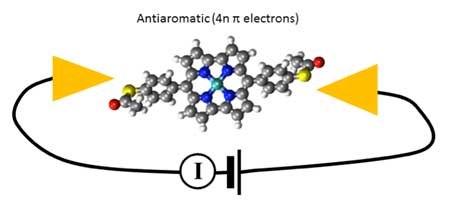| Posted: Aug 16, 2017 | |
Conductance of an anti-aromatic molecule measured for the first time |
|
| (Nanowerk Spotlight) Molecular electronics aims to use small organic molecules as the active component in an electrical circuit in order to tailor functionality and achieve new levels of miniaturization with increased functionality via chemical design. Anti-aromatic molecules had been predicted decades ago to have excellent conducting properties. | |
| Now researchers have realized a molecular circuit involving an anti-aromatic molecule for the first time. | |
| Conjugated molecules are ideal systems for molecular electronics due to the delocalized nature of π electrons. Aromatic molecules are a class of materials which have 4n+2 electrons in the π system (where n is a natural number) and are commonly used in single molecule electronics. Now a new class of organic materials has been shown to be very promising for molecular electronics. Anti-aromatic molecules instead have 4n π electrons and are notoriously unstable and hard to synthesize. | |
| Electrochemical measurements from oxidation/reduction potentials in the 1970s had suggested that anti-aromatic molecules would be very well suited for single molecule transport but efforts in measuring the conductance of a genuinely anti-aromatic molecule had not been successful until now. | |
| Writing in the journal Nature Communications ("Highly-conducting molecular circuits based on anti-aromaticity"), a team of researchers from Japan and the Czech Republic has shown that an anti-aromatic molecule is much more conducting than its aromatic counterpart. | |
 |
|
| Schematic of a single molecule circuit. A molecule is contacted between two sharp nanoelectrodes and a small voltage is applied between source and drain. Current flow across the molecule is determined by molecular chemical properties. In this work, the electrical conductance of a genuinely anti-aromatic molecule was measured for the first time. It was found to be much more conducting than its aromatic counterpart. (Image: Hector Vazquez, Institute of Physics of the Academy of Sciences of the Czech Republic) | |
| The team involved the groups of Hiroshi Shinokubo from Nagoya University, Hector Vazquez from the Institute of Physics of the Academy of Sciences of the Czech Republic, and Manabu Kiguchi from Tokyo Institute of Technology. | |
| The team synthesized and measured a stable anti-aromatic norcorrole-based Ni complex and compared it to its structurally similar porphyrin-based aromatic counterpart. | |
| To measure conductance, the team used the STM–break junction technique, where an STM tip is brought repeatedly in and out of contact while a small voltage is applied. | |
| The researchers found that the anti-aromatic molecule is 25 times more conducting than the aromatic counterpart. Atomistic simulations based on DFT explained the origin of this high conductance, which arises from the alignment of frontier orbitals at the interface: in the anti-aromatic species, the conducting orbital is closer to the Fermi level than in the aromatic system. The conductance of the anti-aromatic molecule could be further tuned electrochemically. | |
| In addition to confirming the long-standing prediction on the conductance of anti-aromatic molecules, this work demonstrates their potential as highly conducting molecular materials for molecular electronics. | |
|
Provided by the Institute of Physics of the Czech Academy of Sciences as a Nanowerk exclusive.
|
|
|
Become a Spotlight guest author! Join our large and growing group of guest contributors. Have you just published a scientific paper or have other exciting developments to share with the nanotechnology community? Here is how to publish on nanowerk.com. |
|
